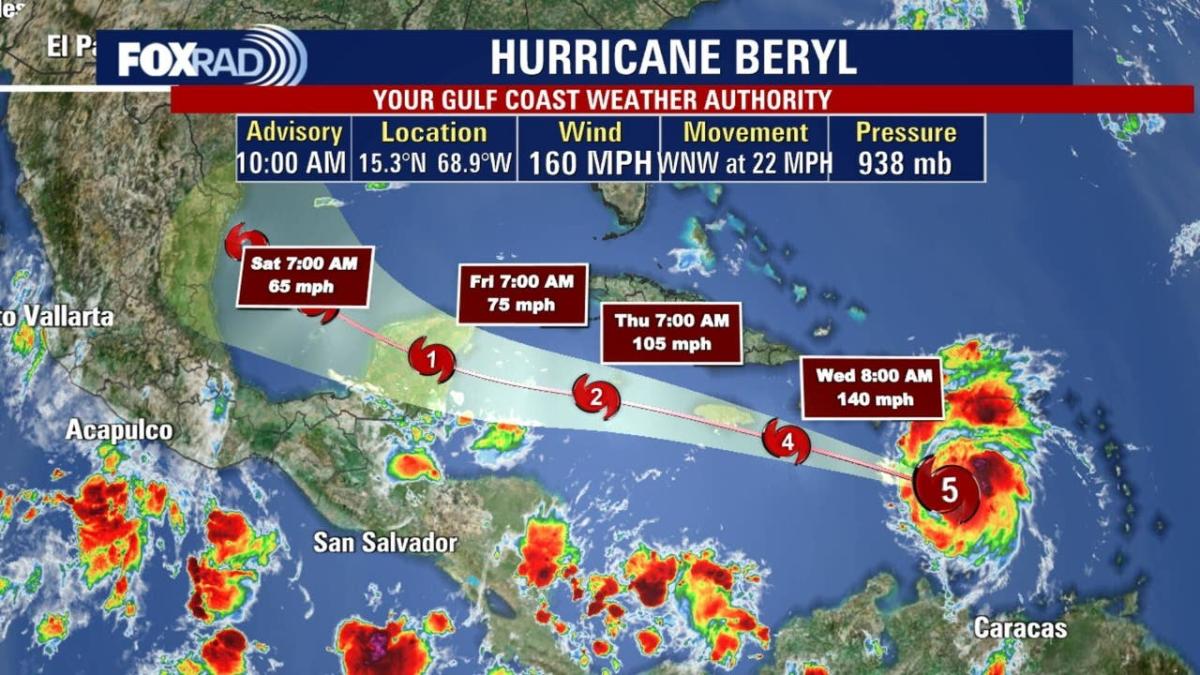Hurricane Beryl’s Path and Intensity
Hurricane beryl tracker – Hurricane Beryl, a Category 3 storm, is currently located approximately 100 miles east-southeast of Bermuda. It is moving northwest at 15 mph and is expected to continue on this path for the next 24 hours. After that, it is predicted to turn north-northeast and accelerate towards the Canadian Maritimes.
The Hurricane Beryl Tracker provides up-to-date information on the path of Hurricane Beryl. As the hurricane approaches Jamaica, residents are advised to take precautions and stay informed about the latest developments. Click here for more details on the hurricane’s projected path and potential impact on Jamaica.
The Hurricane Beryl Tracker will continue to monitor the hurricane’s progress and provide updates as they become available.
Beryl has maximum sustained winds of 125 mph, with gusts up to 150 mph. The central pressure is 952 mb. These conditions are expected to remain relatively stable over the next 24 hours, with a slight decrease in wind speed and increase in pressure anticipated as the storm moves northward.
As Hurricane Beryl approaches the Gulf Coast, residents should stay informed with the latest tracking updates. For the latest news on the storm, visit our Pittsburgh Steelers Brandon Aiyuk page. There you’ll find real-time updates on the storm’s path, intensity, and potential impacts.
Don’t wait until it’s too late, prepare for Hurricane Beryl now by staying informed.
Historical Data
In the past, hurricanes that have followed similar paths to Beryl have typically weakened as they moved northward over cooler waters. However, there have been exceptions. In 2010, Hurricane Earl maintained its intensity as a Category 4 storm as it passed over the Canadian Maritimes. This is a reminder that even weakened hurricanes can still pose a significant threat.
Potential Impacts of Hurricane Beryl: Hurricane Beryl Tracker
![]()
Hurricane Beryl is expected to bring a range of potential impacts to coastal areas, including storm surge, flooding, and wind damage. The areas most likely to be affected by the hurricane are those along the southeastern coast of the United States, particularly in Florida, Georgia, and South Carolina.
Storm Surge
Storm surge is a dangerous wall of water that can reach heights of up to 10 feet or more. Storm surge can cause extensive damage to coastal property, including homes, businesses, and infrastructure. It can also lead to flooding, which can further damage property and displace residents.
Flooding, Hurricane beryl tracker
Flooding can occur in coastal areas due to storm surge, heavy rainfall, and overflowing rivers. Flooding can damage homes, businesses, and infrastructure, and can also lead to the spread of disease. Vulnerable populations, such as the elderly, children, and those with disabilities, are particularly at risk from flooding.
Wind Damage
Hurricane Beryl is expected to bring high winds, which can cause damage to trees, power lines, and buildings. High winds can also lead to power outages, which can disrupt essential services and make it difficult for residents to communicate with each other.
Tracking and Monitoring Hurricane Beryl

The path and intensity of Hurricane Beryl are being closely monitored by meteorologists and weather experts using various tools and techniques. Satellite imagery provides real-time images of the storm, allowing forecasters to track its movement and development. Radar data helps determine the storm’s structure and rainfall patterns. Weather balloons equipped with sensors are released into the atmosphere to collect data on temperature, pressure, and wind speed, providing valuable information for forecasting models.
Weather Forecasting Models
Numerical weather prediction models are computer programs that use complex mathematical equations to simulate the behavior of the atmosphere. These models incorporate data from satellites, radar, and weather balloons to predict the future path and intensity of hurricanes. By running multiple simulations with slightly different initial conditions, meteorologists can assess the uncertainty in the forecast and provide probabilistic guidance on the storm’s potential impacts.
Real-Time Tracking Tools
The National Hurricane Center (NHC) provides real-time tracking tools and resources to the public. The NHC’s website features interactive maps and satellite imagery that allow users to monitor the storm’s progress. The NHC also issues regular advisories and forecasts, providing updated information on the storm’s location, intensity, and potential impacts.
